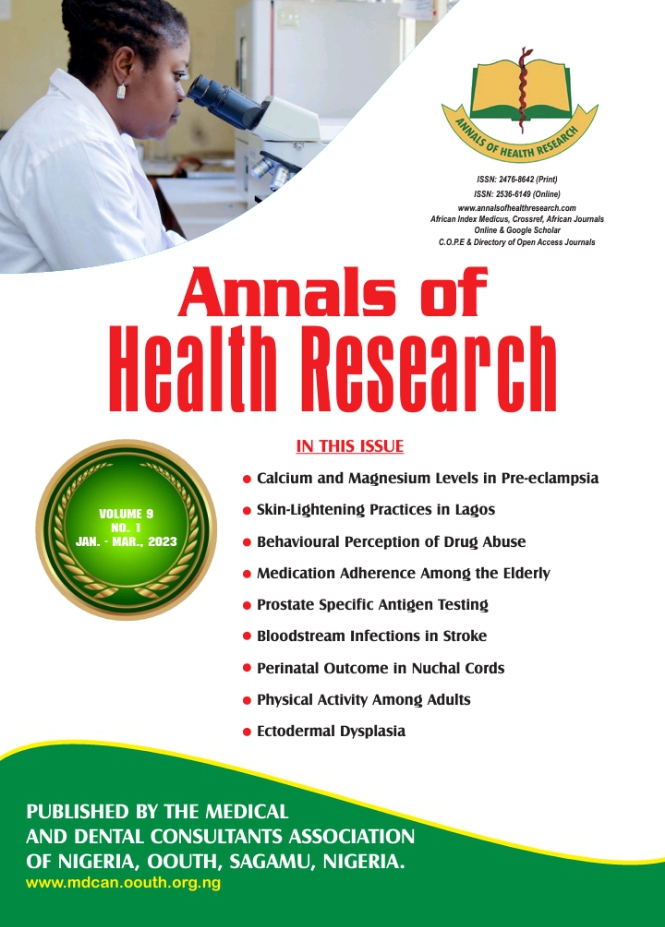Cord Length, Umbilical Artery Lactate Concentration and Perinatal Outcomes of Babies with Nuchal Cord at Ile-Ife, Nigeria
DOI:
https://doi.org/10.30442/ahr.0901-07-191Abstract
Background: There is inconclusive evidence on the relevance of the nuchal cord in obstetric practice.
Objectives: This study aims to evaluate the umbilical artery lactate concentration and perinatal outcomes of babies born with a nuchal cord.
Methods: In a cross-sectional study at the Obafemi Awolowo University Teaching Hospital, babies born with a nuchal cord at term and matched controls without a nuchal cord were recruited between January 2017 and December 2018. Gestational age at delivery, meconium-stained liquor, foetal heart rate abnormalities, Caesarean section rates, cord lengths and umbilical artery lactate concentrations were compared. The umbilical artery lactate concentration was assayed with the Lactate-Plus®; neonatal acidosis was defined as cord lactate concentration > 4.9mmol/L.
Results: One hundred and forty-four babies with nuchal cords and 144 controls were recruited. The prevalence of nuchal cord was 3.4%, with 80% of the babies having a single loop. Babies with nuchal cords had longer mean cord length (57.7cm vs 45.4cm; p<0.01), higher mean umbilical artery lactate (4.93mmol/L vs 3.48mmol/L; p = 0.04), meconium-stained liquor (16% vs 3.2%; Relative risk = 4.6), more babies with Apgar score <7 at fifth minute (9 versus 4 babies) and increased perinatal mortality (55.5/1000 births vs 13.8/1,000 births; Relative risk = 4). There was a positive correlation between cord length and the number of nuchal loops (r = 0.5, p<0.01).
Conclusions: Nuchal cord is associated with abnormal cord lactate concentration and adverse perinatal outcomes. Prenatal reporting may enhance intrapartum surveillance and improve perinatal outcomes.
References
Royal College of Obstetricians and Gynaecologists. Umbilical Cord Prolapse: Green-top Guideline No.50. London: RCOG; 2014.
Kilby MD, Bricker L, on behalf of the Royal College of Obstetricians and Gynaecologists. Management of monochorionic twin pregnancy. BJOG. 2016;124:e1–e45.
Sangwan V, Sangwan M, Siwach S, Mahendroo R, Kansal R, Lakra P. Ultrasonographic detection of nuchal cord: required or not. Int J Reprod Contracept Obstet Gynecol 2014;3:507-511. https://doi.org/10.5455/2320-1770.ijrcog20140908.
Mekala N, Allanki S. A Rare Case Scenario of Sextuple Nuchal Cord Entanglement. J South Asian Feder Obst Gynae 2021;13:194-195. https://doi.org/10.5005/jp-journals-10006-1906.
Mastrobattista JM, Hollier LM, Yeomons ER. Effects of nuchal cord on birth weight and immediate neonatal outcome. Am J Perinatol 2005;22:83-85. https://doi.org/10.1055/s-2005-837737.
Henry E, Andres RL, Christensen RD. Neonatal outcomes following a tight nuchal cord. J Perinatol. 2013;33:231. https://doi.org/10.1038/jp.2012.79.
Ibrahim GA, Safwat MA, Abdel MS, Gadalla SH. The Association between Nuchal Cord Detection and Perinatal Outcomes in Term Infants: A Prospective Study. Med J Cairo Univ 2021;89:267-272.
Simon LV, Hashmi MF, Bragg BN. APGAR Score. StatPearls [Internet]. Treasure Island (FL): StatPearls Publishing; 2022.
Young C, Ryce A. Fetal Scalp Lactate Testing During Intrapartum Pregnancy with Abnormal Fetal Heart Rate: A Review of Clinical Effectiveness, Cost-Effectiveness, and Guidelines. Canadian Agency for Drugs and Technologies in Health; 2018 Mar 26 Table 7, Summary of Included Evidence-Based Guidelines. 2018.
Hayes DJL, Warland J, Parast MM, Bendon RW, Hasegawa J, Banks J, et al. Umbilical cord characteristics and their association with adverse pregnancy outcomes: A systematic review and meta-analysis. PLoS ONE 2020;15:e0239630. https://doi.org/10.1371/journal.pone.0239630.
Kirkwood BR and Sterne JAC. Comparison of two means: confidence intervals, hypothesis tests and P-values. In: Essential Medical Statistics. 2003: 2nd Edition, Blackwell Science, Oxford, 58-70.
Kobayashi N, Aoki S, Oba MS, Takahashi T, Hirahara F. Effect of Umbilical Cord Entanglement and Position on Pregnancy Outcomes. Obstet Gynecol Int 2015;2015:342065. https://doi.org/10.1155/2015/342065.
Balkawade NU, Shinde MA. Study of length of umbilical cord and fetal outcome: a study of 1,000 deliveries. J Obstet Gynecol India. 2012;62:520-525. https://doi.org/10.1007/s13224-012-0194-0.
Peesay, M. Nuchal cord and its implications. Matern Health, Neonatol and Perinatol; 2017: 3(28): 1-11. https://doi.org/10.1186/s40748-017-0068-7
Abdallah A, Eldorf A, Sallam S, Ahmed S, Shawky M, Nawara M, et al. Nuchal cord: impact of umbilical artery Doppler indices on intrapartum and neonatal outcomes: a prospective cohort study. J Matern Neonatal Med 2018:18:3367–3378. https://doi.org/10.1080/14767058.2018.1463984.
Neacsu A, Herghelegiu CG, Voinea S, Dimitriu MCT, Ples L, Bohiltea RE, et al. Umbilical cord lactate compared with pH as predictors of intrapartum asphyxia. Exp Ther Med 2021;21:80. https://doi.org/10.3892/etm.2020.9513.
Nova Biomedical. Lactate Plus Instruction for use Manual. 2019.
Chilinda GK, Gadama LA, Stones W. Point-of-care umbilical arterial lactate and newborn outcomes in a low resource setting: cohort study. BMC Res Notes 2018;11:477. https://doi.org/10.1186/s13104-018-3598-9.
Downloads
Published
Issue
Section
License
Copyright (c) 2023 Annals of Health Research

This work is licensed under a Creative Commons Attribution-NonCommercial 4.0 International License.
The articles and other materials published in the Annals of Health Research are protected by the Nigerian Copyright laws. The journal owns the copyright over every article, scientific and intellectual materials published in it. However, the journal grants all authors, users and researchers access to the materials published in the journal with the permission to copy, use and distribute the materials contained therein only for academic, scientific and non-commercial purposes.


